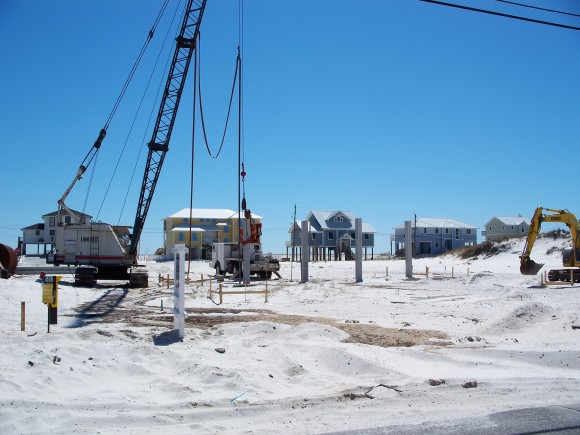This week marks the 10th anniversary of Hurricane Ivan, one of the costliest tropical storms to ever hit the U.S. Ivan came ashore near Gulf Shores, Alabama, on Sept. 16, 2004, as a Category 3 storm. The storm also battered Florida’s Panhandle. It left behind an estimated $14.2 billion in damages. In this commentary, Alex Cory, FORTIFIED Coastal Programs Manager, Insurance Institute for Business & Home Safety (IBHS), discusses how Ivan taught Alabama and neighboring states the importance of building stronger.
It has been 10 years since Hurricane Ivan roared ashore in Baldwin County, Alabama, changing the lives of Alabamians and causing devastation throughout the state and the Gulf Coast region. Ivan was the worst storm to hit Alabama in 25 years and is in the record books as the seventh most costly hurricane ever to affect the United States.
Hurricane Ivan, combined with the other eight hurricanes that affected the Gulf Coast region in 2004 and 2005, was a wake-up call to us all about the vulnerability of our homes, businesses and communities to the wind, storm surge and flooding that accompany these storms.
As a resident of coastal Alabama, I personally saw the terrible result Hurricane Ivan and its aftermath had on our communities. Through my work with Habitat for Humanity of Baldwin County and Smart Home America (SHA) in the years following Ivan, I saw families struggling for a better, yet still affordable, answer to how they could protect their homes and their families against the forces of extreme storms.
While I was still at Habitat for Humanity, SHA partnered with us on a home resiliency demonstration project and introduced us to the Insurance Institute for Business & Home Safety’s (IBHS) FORTIFIED construction program. Through SHA’s efforts to find a workable, affordable solution to building a stronger, more resilient Gulf Coast post-Ivan, they had adopted the FORTIFIED construction standards and led the way in introducing the program to residents and making it a viable and active program in the state.
Created by IBHS based on its years of scientific research and field work following hurricanes and other disasters, FORTIFIED is a voluntary new construction and retrofit program that increases a home’s resilience to natural hazards, such as hurricanes. The program uses a unique systems-based method that allows builders and contractors to work with home buyers and homeowners to choose the desired level of protection that best suits their budgets and resilience goals.
Through the hard work and persistence of organizations like IBHS and SHA, local elected officials and community leaders, FORTIFIED has helped hundreds of homeowners strengthen their homes to make them more disaster-resistant. Alabama also has led the way in making mitigation more affordable by passing legislation in 2009 requiring insurance companies to provide discounts to homeowners in Baldwin and Mobile Counties who achieve a FORTIFIED designation for their homes.
The coastal counties have made other advances during the past ten years that have made them more resilient. Stronger building codes were adopted in the majority of Baldwin County jurisdictions and in the unincorporated areas of Mobile County, based on the 2012 version of the International Residential Code, with a coastal supplement that incorporates FORTIFIED’s Bronze level requirements. These requirements are focused on strengthening the roof, which is a home’s most important and vulnerable component, and the first line of defense against Mother Nature. Orange Beach also has taken the bold step of offering a rebate on building permit fees, to builders or homeowners who build their homes to FORTIFIED’s Gold level standards.
Although Alabama has made improvements in the past ten years to better protect its residents against natural disasters, additional actions by state government could help reach this goal. For example, while the coastal counties have adopted stronger building codes, the rest of Alabama still has a patchwork of code standards. Adopting and enforcing a modern, uniform residential building code throughout the state would increase residents’ personal safety, reduce property damage, and decrease the cost of post-disaster government aid for repairing and rebuilding following natural disasters. In addition, increasing requirements for building contractors statewide in the areas of licensing, continuing education and insurance would ensure that buildings are safer and built to consistent standards.
Lastly, creating and funding a strong state mitigation program to help residents retrofit their homes would provide much-needed assistance to residents in making these building improvements more affordable. The Alabama Department of Insurance and organizations such as Smart Home America, IBHS and others have worked together to put in place the infrastructure for a mitigation program, and are seeking sources of funding to implement this important public safety program for residents.
As the manager of FORTIFIED Coastal Programs for IBHS and Board member of SHA, I am proud to continue educating residents and communities on the importance of more resilient construction in hurricane-prone areas, and working with grassroots organizations and elected officials to create a safer region. The years since Hurricane Ivan have been a learning experience for us all in Alabama, but working together, we have turned the corner and made great strides toward a better future. As we remember the ten-year anniversary of Hurricane Ivan during National Preparedness Month, let’s place a renewed focus on creating a safer, stronger and more prepared Alabama.
Topics Catastrophe Natural Disasters Hurricane Homeowners Construction Alabama
Was this article valuable?
Here are more articles you may enjoy.



 New York Governor Hochul Vows to Tackle Insurance Affordability, Litigation and Fraud
New York Governor Hochul Vows to Tackle Insurance Affordability, Litigation and Fraud  SIAA Announces Strategic Partnership With Progressive
SIAA Announces Strategic Partnership With Progressive  Experian: AI Agents Could Overtake Human Error as Major Cause of Data Breaches
Experian: AI Agents Could Overtake Human Error as Major Cause of Data Breaches  Court Orders Justice Family Coal Companies to Pay $1M to Liberty Mutual Unit
Court Orders Justice Family Coal Companies to Pay $1M to Liberty Mutual Unit 

